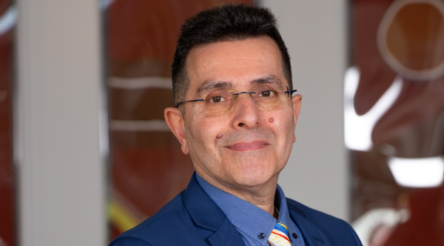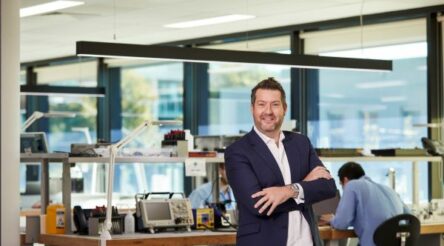AUKUS innovation: about far more than submarines – by Michael Sharpe

The focus of reporting on the AUKUS agreement between Australia, the US and the UK has been on the promise of locally built nuclear-powered submarines. But it is about so much more from AI and quantum computing, to hypersonic aircraft and systems. Here, Michael Sharpe explains how AUKUS will unlock the power of innovation Pillar Two of the agreement – Technology and Capabilities.
The Second Pillar of AUKUS focuses on enhancing the initial goal of constructing nuclear submarines for Australia.
By strengthening trilateral defence and security capabilities, this effort will not only boost the effectiveness of maritime forces, but also speed up the defence innovation processes of the three countries, allowing us to learn from each other and create the swift integration of commercial technologies to address warfighting requirements.
Pillar Two is where Australia already excels.
For example, the AUKUS Quantum Arrangement (AQuA) will accelerate investments to deliver generation-after-next quantum capabilities.
Australia is home to world-renowned researchers in quantum computing, such as Dr Andrew Horsley and his team at Quantum Brilliance, who are developing mass deployment of quantum accelerators.
At Silicon Quantum Computing, the former Australian of the Year, Scientia Professor Michelle Simmons has pioneered ground-breaking advancements in creating electronic devices with atomic precision, including the world’s first single-atom transistor and the narrowest conducting wires.
With these innovations, Australia is poised to play a significant role in advancing trilateral lines of effort for critical defence and security capabilities.
Autonomous systems.
With the AUKUS Undersea Robotics Autonomous Systems (AURAS) project, the AUKUS nations are pursuing cutting-edge technology in the form of autonomous underwater vehicles, which will greatly enhance the capabilities of our maritime forces.
In 2022, US technology firm Anduril established an independent entity, Anduril Australia, and appointed former strategic negotiation adviser for Australia’s Future Submarine program, David Goodrich OAM to lead the expansion.
Anduril Australia was contracted on a three-year, $140 million deal by the Australian Defence Force’s Next Generation Technologies Fund – it must deliver three operational prototype underwater drones capable of carrying sensors and weapons over great distances and dive to depths of up to 6km.
Anduril CEO, Brian Schimpf said: “The Australian Defence Force has long punched above its weight and been in the vanguard of regional security in the Indo-Pacific region, a role they will be asked to play more and more in the coming decades.
“Landmark treaties like AUKUS are signs that the century-long bond between the United States and Australia is only growing tighter and stronger.
“Australia has also embraced and deployed cutting-edge military technology — RAAF’s Loyal Wingman program is now one of the most impressive and innovative defence programs in the world. Add to all that a rich bed of Aussie STEM talent, and Australia is the perfect place for Anduril to grow.”
AI and autonomy
The AUKUS nations are leveraging AI and autonomy to enhance future force capabilities and remain at the forefront of technology.
The trilateral effort is aimed at speeding up the implementation of autonomous and AI-enabled systems, while also ensuring resilience in challenging environments. This joint initiative will enhance decision-making processes, providing a decisive advantage and protecting against AI-related threats.
AUKUS places a strong emphasis on strengthening its cyber capabilities as part of Pillar Two, with a focus on safeguarding critical communications and operational systems in the rapidly evolving cyber domain.
Australian cybersecurity firm Internet 2.0 has secured a $50 million valuation as part of a private funding round. The new capital will help with product development and to expand its team.
The company’s customers include Australian and US government agencies. In addition, the company is now on the ground in Ukraine.
Major General (Retd) Fergus McLachlan AO joined Internet 2.0’s board last year and the board includes former South Australian Innovation Minister Thomas Kenyon.
Kenyon said: “Internet 2.0 has defied market dynamics to deliver a significant increase in value for shareholders.
“It speaks to the reality that cybersecurity is a critical and fast growing market. Internet 2.0 contributes to Australia’s outsized leadership role in international cybersecurity.”
Australia’s expertise in the field of advanced technology is highlighted in the Second Pillar of AUKUS.
The three countries aim to collaborate on enhancing electronic warfare capabilities by sharing knowledge of tools, techniques, and technology to better operate in the increasingly contested electromagnetic spectrum. This will enable our forces to effectively navigate degraded environments.
The AUKUS partners will work together to accelerate development of advanced hypersonic and counter-hypersonic capabilities.
Hypersonix Launch Systems is an Australian space startup developing scramjet and scramjet-based access-to-space technology and systems. Hypersonix’s unique core technology is the SPARTAN scramjet engine – a fixed geometry (no moving parts), self-igniting, hydrogen powered, 3D printed, reusable scramjet capable of speeds from Mach 5 to Mach 10.
Hypersonix Co-Founder, Michael Smart graduated with a Bachelor of Mechanical Engineering from The University of Queensland (UQ) in 1985 and received a PhD from Polytechnic University, Brooklyn, New York in 1995.
Smart then spent 10 years as a research scientist in the Hypersonic Airbreathing Propulsion Branch at NASA’s Langley Research Center, before returning to the University of Queensland in 2005.
In 2007 he was appointed Professor and Chair of Hypersonic Propulsion. As head of UQ’s HyShot Group, he conducted scramjet flowpath related research, with particular emphasis on flight applications.
AUKUS Pillar Two will allow more commercialisation.
With a focus on accelerating the defence innovation efforts of each country, this collaboration will foster learning and exchange of best practices for integrating commercial technologies to meet warfighting needs more efficiently.
The AUKUS partners will have the increased ability of sharing sensitive information, starting with workstreams that support joint efforts to develop advanced capabilities.
In Washington this week, with regards to construction of nuclear powered submarines, Defence Minister Richard Marles said: “The sense I get in conversations I’ve had on the hill is people do understand the strategic benefit for the US of Australia attaining this capability…in every meeting, the sense of commitment from both the UK and the US towards this has just been fantastic.”
I have no doubt that AUKUS Pillar Two will expand rapidly and we will all benefit for generations to come.
Michael Sharpe is the Director of the AUKUS Forum. He is the Chairman of the Sharpe Family Office and is involved with a range of organisations across engineering, infrastructure, energy, environmental sustainability, the Australian space industry and the global nuclear industry.
Picture: Michael Sharpe
@aumanufacturing Sections
Analysis and Commentary Awards Defence Manufacturing News Podcast Technology Videos










